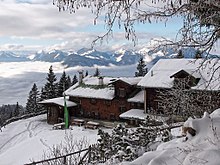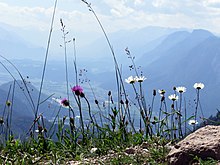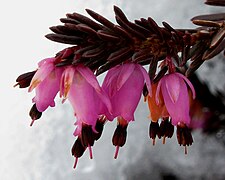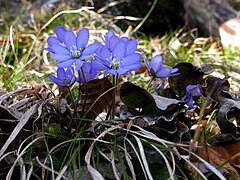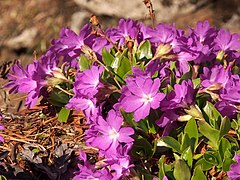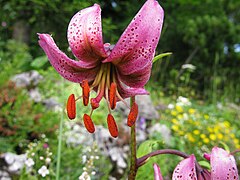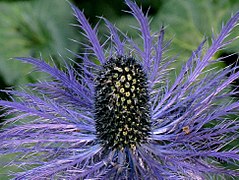Vorderkaiserfelden Alpine Plant Garden
The Vorderkaiserfelden Alpine Plant Garden is a stone and rock garden with a focus on Alpine flora . It is located in the Northern Limestone Alps in the Kaiser Mountains on the southwest spur of the Zahmer Kaiser next to the Vorderkaiserfeldenhütte. The garden was laid out in 1930 and has been looked after by the Association for the Protection of the Mountains ever since . It covers around 600 m² with over 300 plant species from the Alpine region.
Origin and history
The Vorderkaiserfelden Alpine Plant Garden was founded by two people from Munich, the banker Paul Schmidt and the government inspector Willy Weisheit. Both were members of the then "Association for the Protection of Alpine Plants" and the Oberland section of the German and Austrian Alpine Association at the time . The garden is located on a property owned by the DAV Oberland section. The section also owns an area of around 150 hectares in this area of the Zahmer Kaiser. The inauguration of the garden took place on June 22, 1930. In the first two decades after its founding, repeated border barriers and the Second World War made it difficult to maintain the garden. An official new beginning took place with an inauguration on May 22, 1952. In the previous years, the plant population increased from around 400 to over 950 species, of which only a part was able to establish itself permanently.
Goal setting
With the Vorderkaiserfelden Alpine Plant Garden , the founding fathers wanted to bring the beauty and diversity of the Alpine flora closer to the broadest possible audience and contribute to the protection of nature in the mountains, as defined in a newspaper article by the Tiroler Grenzbote on June 27, 1930:
“We know that the human protection of alpine plants is often badly done, and ... that some mountain plants are approaching extinction due to incomprehensible plant robbery. It is true that the governments of the mountainous countries ... endeavor to stop this. It seems to us that it is more important to have an educational influence on the general public in plant protection. To serve this purpose, so-called alpine plant gardens - originally intended mainly for scientific tasks - are ideally suited if they make the essential mountain flora accessible to everyone. "
Location and geology
The garden is located in the northern part of the Tyrolean Limestone Alps at approx. 1400 m altitude in the Kaisergebirge nature reserve on a slope facing south-west, so that the first small areas are often snow-free as early as April, whereas in the forest shade of the upper area and in shady locations there is snow remains lying down longer. From a geological point of view, the peaks of the Kaiser Mountains and the area around the garden consist of Wetterstein limestone . The garden itself is predominantly characterized by Raibler layers , but also interspersed with Wetterstein limestone cribs and blocks. From the garden you can see the rock faces of the Wilder Kaiser and over the Tyrolean Inn Valley to the Stubai Alps . The garden is in the immediate vicinity of the Alpine Club hut of the same name in the Oberland section of the German Alpine Club, the Vorderkaiserfeldenhütte .
Surrounding vegetation
The mountain forest dominated by spruce (Calamagrostido-Piceetum) is characteristic of the vegetation at this altitude and in the immediate vicinity of the garden. On the alpine pastures around the Vorderkaiserfeldenhütte, due to the pending Raibler layers, the Alpine fat pasture (Poo-Prunelletum) occurs. Down the slope in the direction of the Ritzau-Alm, crested grass willows (Alchemillo-Cynosuretum), golden oat meadows (Poo-Trisetetum) and semi-arid grasslands of the Festuco-Brometea class can be found on the pastures. On the north-west exposed slopes below Vorderkaiserfelden, carbonate-Alpendost-spruce-fir-beech forests grow thickly (Adenostylo glabrae-Abieti-Fagetum).
Plants in the garden
From spring until well into autumn, the alpine plants with their budding, the blossoms and fruits and the autumn colors offer colorful and varied images. Immediately after the snow has melted bloom snow Rose ( Helleborus niger ), soldanella alpina ( Soldanella alpina ) and Leucojum ( Leucojum vernum ), followed closely by Schneeheide ( Erica herbacea ), liverwort ( hepatica nobilis ) and Seidelbast ( Daphne mezererum ). At the beginning of May the primrose species dominate: in bright pink the east alpine Clusius primrose ( Primula clusiana ), pale yellow the stemless cowslip ( Primula vulgaris ) and the high cowslip ( Primula elatior ), in bright yellow the auricles ( Primula auricula ). Mid-June is the main flowering time in the garden, starting with the Turk's cap lily ( Lilium martagon ). This is followed in July by the magnificent flowers of the lashed alpine rose ( Rhododendron hirsutum ), followed by the yellow gentian ( Gentiana lutea ) and the large star umbel ( Astrantia major ). August and September is the flowering time of many tall herbaceous species such as alpine man litter ( Eryngium alpinum ), monkshood ( Aconitum variegatum ), wolf monkshood ( Aconitum lycoctonum ) and swallowwort gentian ( Gentiana asclepiadea ).
- The blooming year in the Vorderkaiserfelden Alpine Plant Garden ...
Personalities
Paul Schmidt (1899–1976), one of the two founders of the Vorderkaiserfelden Alpine Plant Garden, was a member of the Bund Naturschutz in Bayern and co-editor of the “Blätter für Naturschutz”. From 1935 to 1974 he held changing functions on the board of the Association for the Protection of the Mountains, and from 1971 until his death he was honorary chairman. Schmidt was significantly involved in the re-establishment of the Association for the Protection of the Mountains in 1947. Willy Weisheit, the second founder, also looked after an alpine plant garden on the Neureuth east of the Tegernsee, which no longer exists today. From 1976 to 1979 Hans Smettan, a botanist from Oberaudorf, took care of the garden. For a total of 20 years (1991–2011) the garden was looked after by Hans-Jürgen Götzke, district gardener at the Munich Botanical Garden .
Access
The alpine garden is open from May to October, depending on the snow conditions. Accordingly, the two main entrances to the Vorderkaiserfeldenhütte are easily accessible during this time.
- The most famous route starts in Kufstein . From the “Kaisertal” car park in Kufstein- Sparchen via the Sparchenstiege to the Kaisertal, via Veitenhof and Ritzaualm, then on the signposted hiking trail to the Vorderkaiserfelden hut ( 1388 m above sea level ), with the alpine garden right next to it. Walking time: approx. 2.5 hours.
- The tour from Ebbs / Reit, which can be reached by train and bus, is also popular. From the “Postamt” bus stop, the route between Gasthaus Oberwirt and the church takes you to Kaiserbergstrasse, in the direction of Aschinger Alm, via Musikantenweg (No. 811) to Musikantenrast. From there it goes on the signposted somewhat steep path to the Vorderkaiserfeldenhütte. Walking time: approx. 3 hours.
literature
- Association for the Protection of the Mountain World (publisher): Leaflet Alpine Plant Garden Vorderkaiserfelden (PDF)
- W. Bernhard Dickoré, Sabine Rösler, Heinz Staudacher: The alpine plant garden Vorderkaiserfelden, 83 years young. In: Yearbook of the Association for the Protection of the Mountains (Munich), 78th year 2013, pp. 221–240 ( PDF ).
- Hans-Jürgen Götzke: The alpine plant garden “Vorderkaiserfelden”. In: Yearbook of the Association for the Protection of the Mountain World (Munich), 65th year 2000, pp. 47–52 ( PDF ).
- Paul Schmidt, Willy Weisheit: From the alpine plant garden in Vorderkaiserfelden (Tyrol). In: Yearbook of the Association for the Protection of Alpine Plants, 6th year 1934, pp. 68–73 ( PDF ).
- Paul Schmidt: From the alpine plant garden on Vorderkaiserfelden near Kufstein (Tyrol). In: Yearbook of the Association for the Protection of Alpine Plants and Animals, 13th year 1953, pp. 71–73 ( PDF ).
- Hans W. Smettan: The plant communities of the Kaiser Mountains / Tyrol. In: Anniversary edition of the Association for the Protection of the Mountain World, 1981, 196 pages and table section ( PDF ).
Web links
Individual evidence
- ^ A b W. Bernhard Dickoré, Sabine Rösler, Heinz Staudacher: The Alpine Plant Garden Vorderkaiserfelden, 83 years young . In: Association for the protection of the mountain world (ed.): Yearbook of the association for the protection of the mountain world . tape 78 . Self-published, Munich 2013, p. 221-240 ( PDF ).
- ^ Ernst Jobst: In memory of Paul Schmidt. Association for the Protection of the Mountains, accessed on September 18, 2017 .
- ↑ Paul Schmidt, Willy wisdom: From the alpine plant garden on Vorderkaiserfelden (Tyrol) . In: Association for the protection of the Alpine plants (ed.): Yearbook of the Association for the protection of the Alpine plants . tape 6 . Self-published, Munich 1934, p. 68-73 ( PDF ).
- ^ Paul Schmidt: From the alpine plant garden on Vorderkaiserfelden near Kufstein (Tyrol). Association for the Protection of the Mountains, accessed on September 19, 2017 .
- ^ Definition of Calamagrostio villosae-Piceetum. Federal Agency for Nature Conservation, accessed on July 15, 2017 .
- ↑ Hans Smettan: The plant communities of the Kaiser Mountains / Tyrol . In: Association for the protection of the mountains (ed.): Anniversary volume of the association for the protection of the mountains . Self-published, Munich 1981.
- ↑ Willy Wisdom: The Alpine Plant Garden on the Neureuth. Association for the Protection of the Mountains, accessed on August 30, 2017 .
- ^ Fritz Edelmann and Benedikt Mohr: Detailed description of the route to the Vorderkaiserfeldenhütte. Bergtour-online.de, accessed on July 15, 2017 .
- ^ Association for the protection of the mountain world: Leaflet Alpine Plant Garden Vorderkaiserfelden. Association for the Protection of the Mountains, accessed on April 26, 2017 .
Coordinates: 47 ° 36 ′ 21.5 " N , 12 ° 14 ′ 23.8" E
